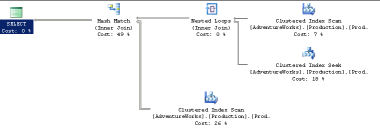Structure of an execution plan
So, this is the first part of the series on how to read an execution plan. In this post, I’m going to give a high-level overview of how the execution plan looks and how, in general, to read it.
For the purposes of this and other posts in this series, all screenshots will be from SQL Management Studio (the 2005 GUI) and all comments on features will refer to that tool. Query Analyser, from SQL 2000, is very similar. For other querying tools, your mileage may vary.
Here’s a very simple execution plan. The query that produced this plan is just a join of three tables in the AdventureWorks database on SQL 2005.
